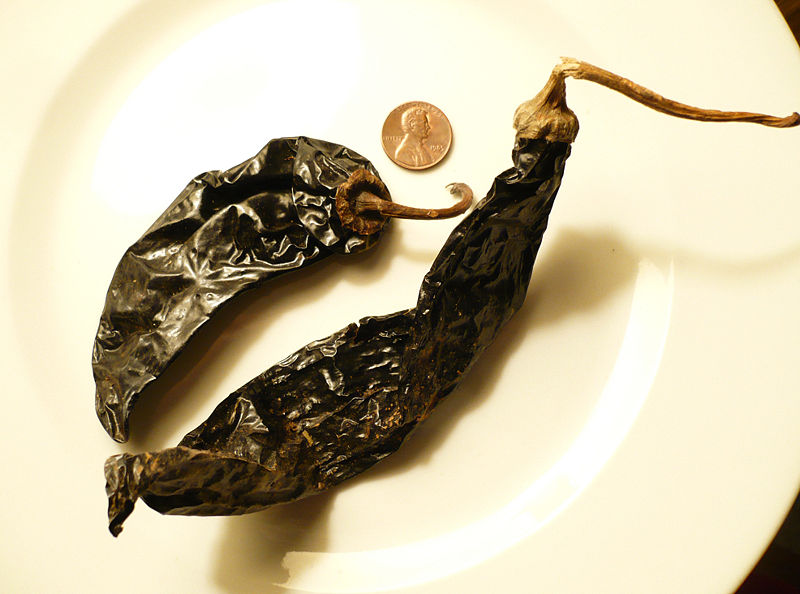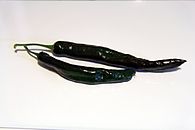The dried form of the chilaca chili pepper, a long, narrow member of the genus Capsicum annuum, is known as the Pasilla Chile or Chile Negro. Its name, which translates to “little raisin,” comes from the dark, wrinkly skin of the chile. It typically measures 1 to 1+12 inches (2.5 to 3.8 cm) in diameter and 6 to 8 inches (15 to 20 cm) long when dried. There are different types of peppers. The narrow chilaca has a twisted shape when it is fresh and can grow to be up to 9 inches (230 mm) long. This shape is rarely visible after drying. When fully grown, it changes from dark green to dark brown. Producers and retailers in the United States occasionally mistakenly refer to the poblano, a different, larger variety of pepper, as “pasilla.” The dried form of this pepper is known as an ancho.
In particular, for the creation of sauces like moles, table sauces, and salsas, pasilla peppers are widely used in Mexican cooking and food. Additionally, the peppers are powdered and used for seasonings or other similar purposes. In Mexico, a lot of peppers are dried for use in food, giving them a completely new name because of the flavors, traits, and uses change drastically.
How Hot Are Pasilla Peppers?
The heat level of pasilla peppers varies somewhat, but they are not particularly scalding. On the Scoville Scale, the peppers range from 250 to 3,999 Scoville Heat Units. The popular jalapeno pepper averages around 5,000 SHU, so when compared to that, the pasilla pepper is between 20 and 1.25 times milder. Although you can find some with respectable heat, the majority are not very hot. Naturally, pasillas fall within the same price range as the fresh chilaca pepper, which is the chili used to make the product by the same name. However, chilaca peppers that have reached their mature red hue are used to make pasilla chilies. Pasillas frequently lean toward the upper end of that range because that ripeness coincides with the peak of the pepper’s capsaicin, the compound responsible for the heat.
The ancho, pasilla, and guajillo chilies are the three dried chilies that make up the Mexican Holy Trinity and are frequently used in mole sauces. When it comes to heat, the pasilla is the middle child of these three. The mildest of the bunch is anchos, which are dried poblanos (1,000 to 1,500 SHU), while guajillos, which are dried mirasol chilies, are just above pasilla (2,500 to 5,000 SHU).
What Does Pasilla Pepper Look Like?
The Spanish word pasilla literally translates to “little raisin,” and although this chili is far from small, it does resemble a raisin in appearance. The skin is wrinkled and dark brownish-red (darker than an ancho or guajillo) like the skin of a raisin. Because of its darker color, the pasilla is occasionally referred to as “chile negro.”
Pasilla typically measures six inches or longer (rarely up to nine inches) and up to two inches wide. These two chilies are frequently mislabeled as one another in grocery stores despite the fact that they aren’t nearly as wide-bodied as an ancho. The width and color can help you decide whether you’re buying a pasilla or an ancho. The two biggest tells are these. Compared to the pasilla’s two-inch width, anchos can be up to four inches wide, and pasillas typically have a much darker color.
What Do Pasilla Peppers Taste Like?
Additionally, the flavor is raisin-like. Pasillas has a sweet flavor with hints of cocoa and even a little berry. Although the ancho pepper tends to be the sweeter of the two while still offering plenty of earthiness in its flavor, it is slightly hotter and earthier than the ancho pepper.
The pasilla, which has a rich, smoky flavor and an earthy undertone, is frequently found in dried whole or powdered form in Mexican salsas, mole sauces, and adobo sauces. Even the standard red chili enchilada sauce’s flavor and appearance can be interestingly altered by the pasilla. It is also well-liked when served alongside fruits or with duck, seafood, lamb, mushrooms, garlic, fennel, honey, and oregano.
Cooking with Pasilla Pepper
As previously mentioned, these chilies are a component of the trio of chilies used to create true mole and enchilada sauces from Mexico. They can be dehydrated and used to make sauces, stews, soups, salsas, hot sauces, pastes, and marinades just like ancho peppers. You can use this kind of pepper to enjoy your alternative traditional spaghetti noodles and pasta. Additionally, they are simple to powder for use as a rub spice. If the peppers are properly stored, it keeps for a long time as a dried chili—more than a year.
Cooking Tips Using Pasilla Pepper
1. Chocolate pairs incredibly well with pasilla. This chili has a ton of rich flavors that go great with cocoa and chocolate desserts, just like guajillo and ancho. It’s a lot of fun to explore this area. You can use pasilla to simply enhance hot chocolate, cakes, or ice cream.
2. If kept on counters in the open, dried chili flavors will lose their flavorful potency. Although they might give the kitchen a nice aesthetic touch, those chilies will eventually lose their complex flavor. Keep them stored in an airtight container out of the direct sun if you want the most intense flavor experience.
3. Keep in mind that even a mild chili pepper still contains hot peppers. Meaning: Mishandling even something as mild as a pasilla can result in chili burn. Use protective gloves when chopping or grinding pasilla.
What’s The Best Pasilla Substitute?
Most people believe that ancho chilies are the best substitute for pasillas. Since they are a little milder, most people can still eat them with ease. Although the flavors are not identical (anchos tend to be sweeter among other differences), they are similar enough to work in many dishes.
Pasilla Pepper vs. Ancho Peppers
The ancho pepper, another incredibly popular dried Mexican chili pepper, should not be confused with the pasilla pepper. In the United States, growers and grocery stores frequently mistake the dried poblano pepper known as the ancho for the pasilla. There is a lot of confusion because the darker anchos are also sometimes called “chile negro,” but they are not the same as pasilla peppers.


